外研版(2019)必修三 Unit 1 Knowing me, knowing you (5)课件(54张ppt)
文档属性
| 名称 | 外研版(2019)必修三 Unit 1 Knowing me, knowing you (5)课件(54张ppt) | 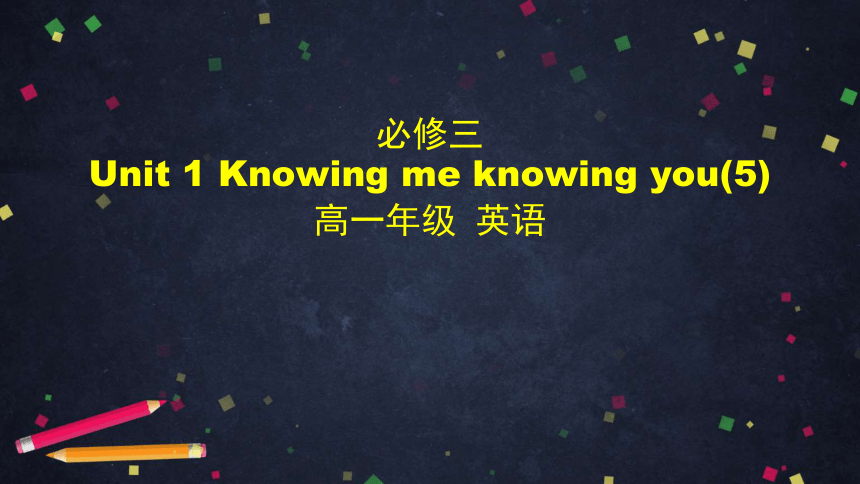 | |
| 格式 | zip | ||
| 文件大小 | 8.2MB | ||
| 资源类型 | 教案 | ||
| 版本资源 | 外研版(2019) | ||
| 科目 | 英语 | ||
| 更新时间 | 2020-06-13 14:54:28 | ||
图片预览


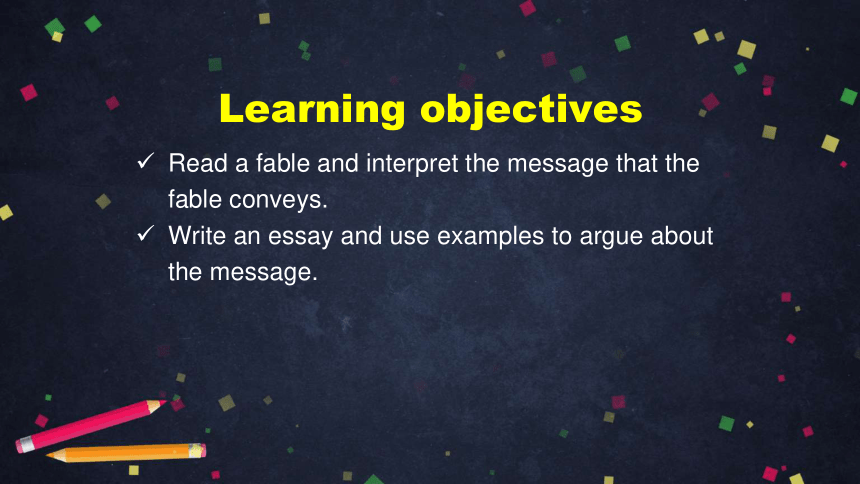
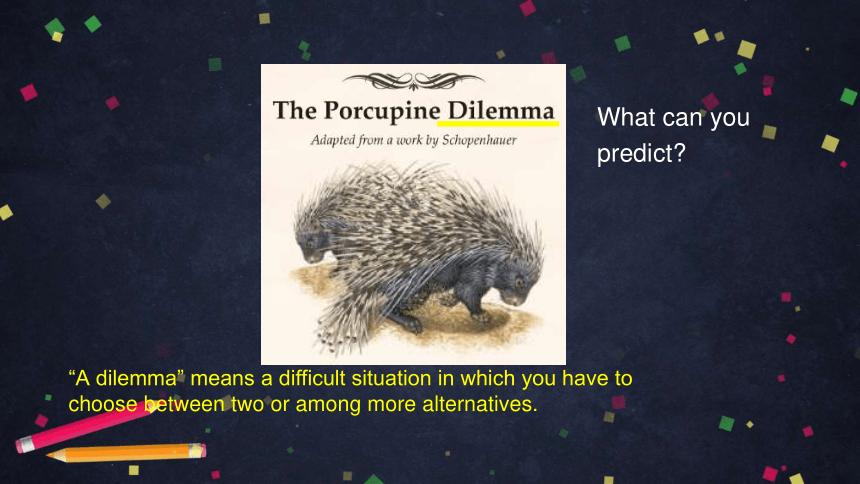
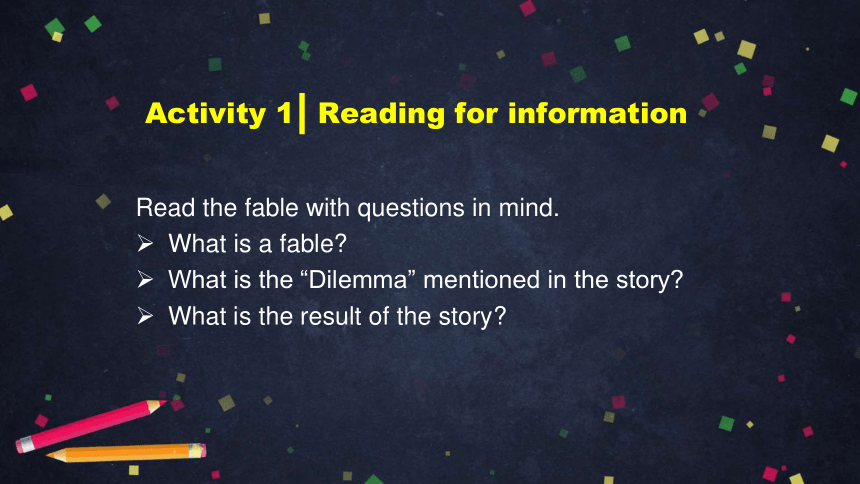

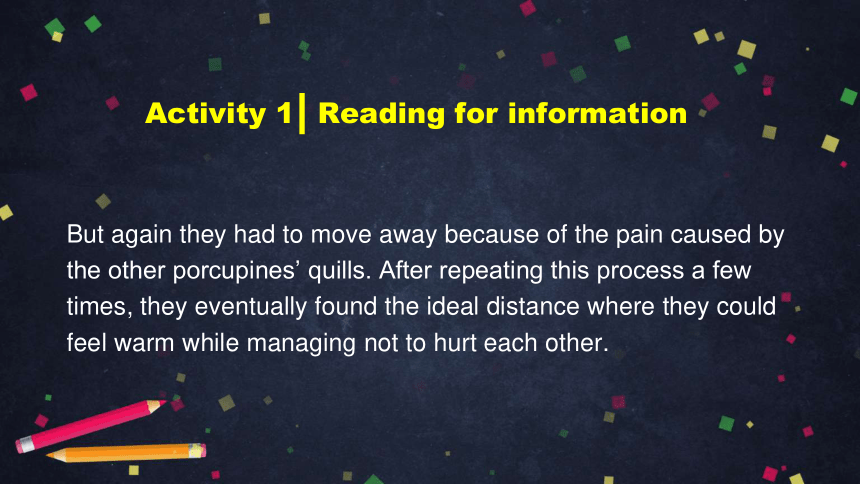
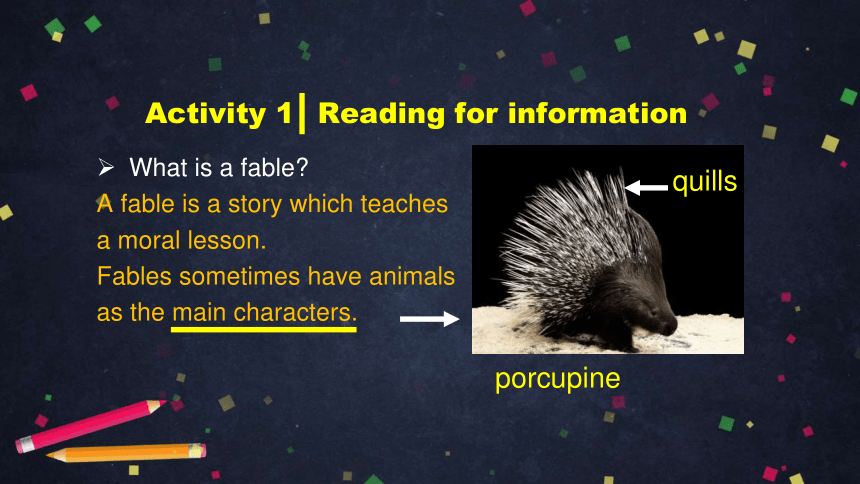
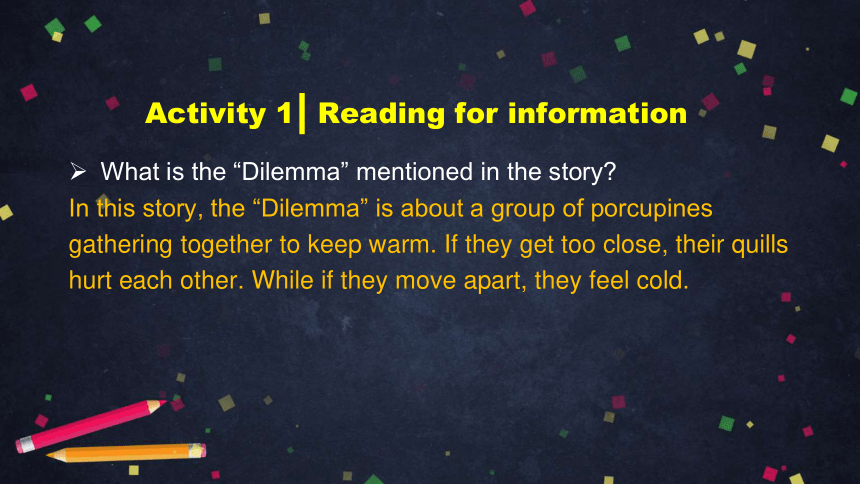
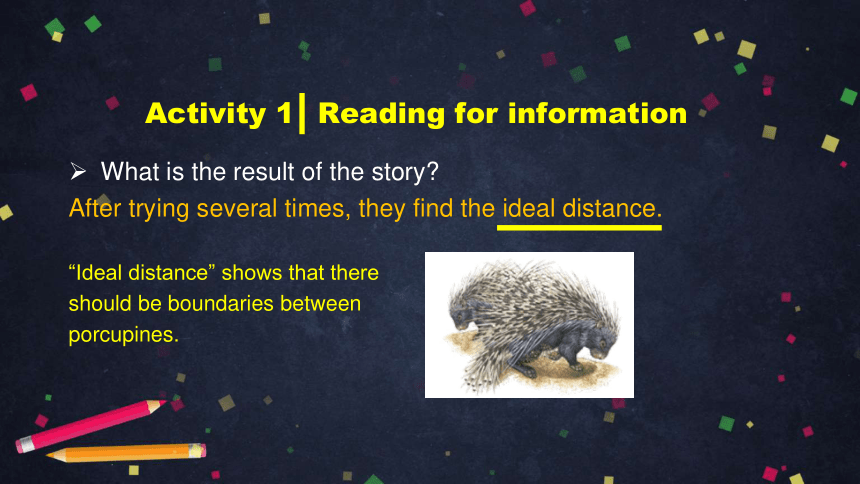
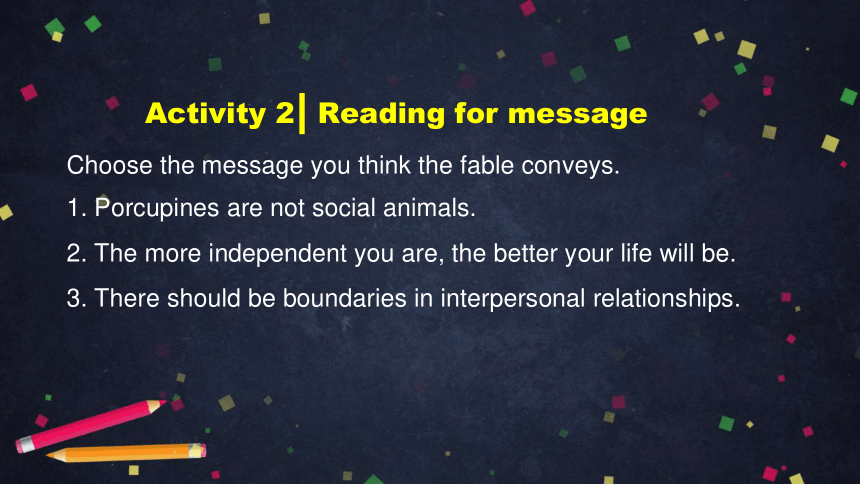
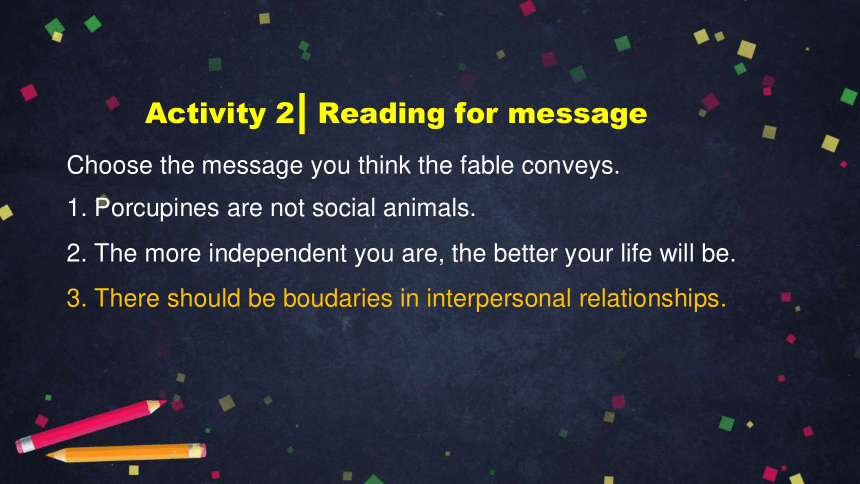
文档简介
(共54张PPT)
必修三
Unit
1
Knowing
me
knowing
you(5)
高一年级
英语
Writing
an
essay
Read
a
fable
and
interpret
the
message
that
the
fable
conveys.
Write
an
essay
and
use
examples
to
argue
about
the
message.
Learning
objectives
What
can
you
predict?
“A
dilemma”
means
a
difficult
situation
in
which
you
have
to
choose
between
two
or
among
more
alternatives.
Read
the
fable
with
questions
in
mind.
What
is
a
fable?
What
is
the
“Dilemma”
mentioned
in
the
story?
What
is
the
result
of
the
story?
Reading
for
information
Activity
1
The
Porcupine
Dilemma
Adapted
from
a
work
by
Schopenhauer
One
cold
winter
night,
a
group
of
porcupines
gathered
together
to
keep
warm.
As
soon
as
they
started
to
get
closer,
they
hurt
each
other
with
their
quills,
so
they
had
to
move
apart.
After
a
short
time,
they
started
to
feel
cold
again,
so
they
moved
closer
together.
Reading
for
information
Activity
1
But
again
they
had
to
move
away
because
of
the
pain
caused
by
the
other
porcupines’
quills.
After
repeating
this
process
a
few
times,
they
eventually
found
the
ideal
distance
where
they
could
feel
warm
while
managing
not
to
hurt
each
other.
Reading
for
information
Activity
1
What
is
a
fable?
A
fable
is
a
story
which
teaches
a
moral
lesson.
Fables
sometimes
have
animals
as
the
main
characters.
porcupine
quills
Reading
for
information
Activity
1
What
is
the
“Dilemma”
mentioned
in
the
story?
In
this
story,
the
“Dilemma”
is
about
a
group
of
porcupines
gathering
together
to
keep
warm.
If
they
get
too
close,
their
quills
hurt
each
other.
While
if
they
move
apart,
they
feel
cold.
Reading
for
information
Activity
1
What
is
the
result
of
the
story?
After
trying
several
times,
they
find
the
ideal
distance.
“Ideal
distance”
shows
that
there
should
be
boundaries
between
porcupines.
Reading
for
information
Activity
1
Choose
the
message
you
think
the
fable
conveys.
1.
Porcupines
are
not
social
animals.
2.
The
more
independent
you
are,
the
better
your
life
will
be.
3.
There
should
be
boundaries
in
interpersonal
relationships.
Reading
for
message
Activity
2
Choose
the
message
you
think
the
fable
conveys.
1.
Porcupines
are
not
social
animals.
2.
The
more
independent
you
are,
the
better
your
life
will
be.
3.
There
should
be
boudaries
in
interpersonal
relationships.
Reading
for
message
Activity
2
Summary
a
fable,
main
character
the
result
getting
close
or
moving
apart
ideal
distance
the
“Dilemma”
a
group
of
porcupines
boundaries
in
interpersonal
relationships
message
conveyed
Reading
for
message
Activity
2
The
fable
is
about
a
group
of
porcupines
gathering
together
to
keep
warm.
If
they
get
too
close,
their
quills
hurt
each
other,
while
if
they
move
apart,
they
feel
cold.
After
trying
several
times,
they
find
the
ideal
distance.
The
fable
tells
us
that
there
should
be
boundaries
in
interpersonal
relationships.
Reading
for
message
Activity
2
The
author
Arthur
Schopenhauer(叔本华)(1788-1860)
was
a
German
philosopher.
Schopenhauer
developed
an
atheistic
metaphysical
and
ethical
system.
His
idea
had
a
great
impact
across
various
disciplines,
including
philosophy,
literature,
and
science.
His
writing
on
aesthetics,
morality,
and
psychology
would
exert
important
influence
on
thinkers
and
artists
throughout
the
19th
and
20th
centuries.
Reading
for
message
Activity
2
What
would
you
say
first
when
sharing
opinions
about
the
story?
Do
you
hold
the
same
idea
with
the
author?
How
could
we
get
people
to
accept
our
ideas?
Reading
for
structure
Activity
3
Writing
an
essay
Reading
for
structure
Activity
3
Introduction
Main
Body
Conclusion
Opinions
Supportings
Inspiration
Writing
an
essay
Introduction
Main
Body
Conclusion
The
summary
of
the
fable
(its
main
message)
Viewpoint
and
supporting
examples
in
your
real
life
What
we
can
learn
from
it.
Reading
for
structure
Activity
3
What
would
you
say
first
when
sharing
opinions
about
the
story?
First,
introduce
the
story,
including
the
original
author
and
the
summary
of
the
story.
Preparing
for
writing
Activity
3
Do
you
agree
with
the
author’s
idea
that
the
fable
conveys?
I
agree
with
the
author’s
idea.
We
need
boundaries
with
our
friends.
How
could
we
get
people
to
accept
our
ideas?
Use
examples
in
our
real
life
to
support
our
opinions.
Preparing
for
writing
Activity
3
Introduction
Original
author:
Schopenhauer
(叔本华)
Summary
of
the
fable:
The
fable
is
about
a
group
of
porcupines
gathering
together
to
keep
warm.
If
they
get
too
close,
their
quills
hurt
each
other,
while
if
they
move
apart,
they
feel
cold.
After
trying
several
times,
they
find
the
ideal
distance.
The
fable
tells
us
that
there
should
be
boundaries
in
interpersonal
relationships.
Notes
and
opinions
Main
body
Viewpoint:
We
need
boundaries
with
our
friends.
Supporting
examples
in
your
real
life:
It
was
a
little
friction
with
my
good
friend.
What
I
did
to
keep
closer
to
her
turn
out
to
be
annoying.
Then
I
realised
my
fault
and
kept
the
ideal
distance
with
my
friend.
Our
friendship
was
repaired.
Notes
and
opinions
Conclusion
We
have
to
find
the
proper
distance
between
us
and
our
friends.
Notes
and
opinions
Write
the
essay
with
the
notes
you
have
made
and
use
the
expressions
below
to
help
you.
This
fable
describes…
The
fable
teaches
us
that…
One
example
of
this
from
real
life
is…
In
conclusion,
…
Writing
an
essay
Activity
4
Publishing
and
Assessing
Activity
5
Language
use
Grade
Content
Organisation
Vocabulary
Grammar
Punctuation
Assessing
an
essay
After
completing
this
essay,
can
you
grade
your
writing?
A
(excellent),
B
(good)
or
C
(in
need
of
improvement)
Content
Grade
The
fable
summary
A
Interpreting
message
Real
life
examples
Content
Grade
The
fable
summary
A
Interpreting
message
B
Real
life
examples
Content
Grade
The
fable
summary
A
Interpreting
message
B
Real
life
examples
C
Organisation
Grade
“I-MB-C”
structure
A
Ideas
well
connected
Introduction
Main
body
Conclusion
Organisation
Grade
“I-MB-C”
structure
A
Ideas
connecting
A
Language
use
Grade
Content
B
Organisation
A
Vocabulary
B
Grammar
A
Punctuation
B
Assessing
an
essay
After
completing
this
essay,
can
you
grade
your
writing?
A
(excellent),
B
(good)
or
C
(in
need
of
improvement)
Publishing
and
Assessing
Activity
5
A
perfect
introduction
of
the
fable,
including
the
author
and
the
message
that
the
fable
conveys.
A
well-founded
passage
structure,
including
real
life
examples
that
can
convince
others.
Clear
and
concise
sentences
and
expressions,
including
various
forms
of
clauses.
No
erro
in
grammar,
spelling
and
punctuation.
Self-assessment
Effective
connections
The
fable
describes…
The
fable
teaches
us
that…
One
example
from
real
life
is…
While
Once
At
first
...
since...
Soon
Then/Since
then
In
conclusion
Revising
and
improving
Activity
6
Good
expressions
is
written
by
cast
a
light
on
share
the
same
ideas
as
try
to
persuade
I
realised/I
have
realised
that
leave
no
room
for
find
our
friendship
repaired
respect
each
other
make
our
friendship
last
long
Revising
and
improving
Activity
6
interpret
the
message
describe
the
details
of
the
example
give
direct
suggestions
The
Porcupine
Dilemma
is
written
by
German
philosopher
Schopenhauer.
The
fable
describes
a
group
of
porcupines
gathering
together
to
keep
warm.
If
they
get
too
close,
their
quills
hurt
each
other.
While
if
they
move
apart,
they
feel
cold.
After
trying
several
times,
they
find
the
ideal
distance.
The
fable
teaches
us
that
there
should
be
boundaries
in
interpersonal
relationships.
Revising
and
improving
Activity
6
Though
it
is
an
old
fable,
it
casts
a
light
on
us
even
today.
We
all
value
friendship,
but
have
you
considered
that
we
need
boundaries
with
our
friends?
One
example
from
real
life
is
like
this.
Once
I
thought
friends
should
get
close
to
each
other,
the
closer
the
better.
Ma
Jing
is
the
first
friend
that
I
made
at
senior
high.
At
first,
I
thought
since
we
were
friends,
she
had
to
share
the
same
ideas
as
mine.
Revising
and
improving
Activity
6
So
I
always
followed
her,
wanted
to
know
her
opinion
on
everything
and
tried
to
persuade
her
when
she
had
a
different
idea.
Soon,
we
started
quarrelling.
“You’re
so
annoying!”
she
shouted
angrily
after
a
quarrel.
How
could
I
become
annoying?
I
felt
hurt
and
discussed
it
with
another
friend.
Revising
and
improving
Activity
6
Then
I
realised
it
was
my
problem.
l
had
been
getting
too
close
to
her
and
leaving
her
no
room
for
herself.
Since
then,
I
stopped
following
her
so
much
and
I
found
our
friendship
repaired.
Now
I
have
realised
that
friends
need
to
have
boundaries
and
respect
each
other,
no
matter
how
close
we
are.
Revising
and
improving
Activity
6
In
conclusion,
in
order
to
make
our
friendship
last
long,
we
have
to
find
the
proper
distance
between
us
and
our
friends,
close
enough
to
understand
each
other,
far
enough
to
respect
each
other.
Revising
and
improving
Activity
6
Learn
to
revise
Revision
is
the
process
of
editing,
analyzing
and
proofreading
to
improve
the
quality
of
a
writing.
Learning
how
to
revise
writing
is
pretty
important.
By
revising,
you
can
improve
the
organization,
clarity
and
accuracy
of
a
written
piece
to
produce
high-quality
content.
Revising
and
improving
Activity
6
Content,
Structure
and
Clarity
Ensure
the
central
point
is
clear.
Ensure
topic
sentences
are
strong.
Ensure
your
paragraph
should
be
about
the
same
length.
Ensure
supporting
sentences
actually
support
your
topic
sentences
and
don’t
introduce
a
different
subject.
Revising
and
improving
Activity
6
Accuracy
1.
Ensure
the
subject
and
verb
match
and
the
tenses
are
correct.
2.
Use
a
mix
of
simple,
compound,
and
complex
sentences.
3.
Double
check
the
spelling
and
punctuation
marks.
Revising
and
improving
Activity
6
Read
the
quotations
and
discuss
their
meanings.
Presenting
ideas
Activity
7
——己所不欲,勿施于人。(孔子)
Presenting
ideas
Activity
7
In
our
life
there
are
too
many
things
that
we
can’t
control
and
unavoidably
we
will
conflict
with
others
in
some
aspects.
If
we
can
think
more
about
others,
there
will
be
more
harmony
instead
of
conflict.
——好篱笆造就好邻居。(谚语)
Presenting
ideas
Activity
7
This
means
that
it
is
better
for
people
to
mind
their
own
business
and
to
respect
the
privacy
of
others.
Keep
an
ideal
distance
and
respect
each
other.
——人类最基本的需要就是理解和被理解。(拉尔夫?尼科尔斯)
Presenting
ideas
Activity
7
It
emphasizes
the
importance
of
understanding
and
being
understood.
Being
understood
is
taking
a
look
at
a
situation
from
another
point
of
view.
Present
your
ideas
basing
on
“I-MB-C”
structure
Introduction
Main
Body
Conclusion
Explanation
of
the
quotation
(its
main
message)
Examples
of
application
in
everyday
life
What
we
can
learn
from
it.
Presenting
ideas
Activity
7
Useful
expressions
We
have
chosen
to
talk
about
the
quotation…
The
main
message
of
this
quotation
is…
In
daily
life,
…
Another
example
is…
In
conclusion,
this
quotation
teaches
us
that
Presenting
ideas
Activity
7
Homework
Option
1
Revise
your
essay
after
class;
Option
2
Choose
one
from
the
three
quotations
on
page
12.
Write
an
essay
to
interpret
the
quotation
and
present
your
ideas.
End
必修三
Unit
1
Knowing
me
knowing
you(5)
高一年级
英语
Writing
an
essay
Read
a
fable
and
interpret
the
message
that
the
fable
conveys.
Write
an
essay
and
use
examples
to
argue
about
the
message.
Learning
objectives
What
can
you
predict?
“A
dilemma”
means
a
difficult
situation
in
which
you
have
to
choose
between
two
or
among
more
alternatives.
Read
the
fable
with
questions
in
mind.
What
is
a
fable?
What
is
the
“Dilemma”
mentioned
in
the
story?
What
is
the
result
of
the
story?
Reading
for
information
Activity
1
The
Porcupine
Dilemma
Adapted
from
a
work
by
Schopenhauer
One
cold
winter
night,
a
group
of
porcupines
gathered
together
to
keep
warm.
As
soon
as
they
started
to
get
closer,
they
hurt
each
other
with
their
quills,
so
they
had
to
move
apart.
After
a
short
time,
they
started
to
feel
cold
again,
so
they
moved
closer
together.
Reading
for
information
Activity
1
But
again
they
had
to
move
away
because
of
the
pain
caused
by
the
other
porcupines’
quills.
After
repeating
this
process
a
few
times,
they
eventually
found
the
ideal
distance
where
they
could
feel
warm
while
managing
not
to
hurt
each
other.
Reading
for
information
Activity
1
What
is
a
fable?
A
fable
is
a
story
which
teaches
a
moral
lesson.
Fables
sometimes
have
animals
as
the
main
characters.
porcupine
quills
Reading
for
information
Activity
1
What
is
the
“Dilemma”
mentioned
in
the
story?
In
this
story,
the
“Dilemma”
is
about
a
group
of
porcupines
gathering
together
to
keep
warm.
If
they
get
too
close,
their
quills
hurt
each
other.
While
if
they
move
apart,
they
feel
cold.
Reading
for
information
Activity
1
What
is
the
result
of
the
story?
After
trying
several
times,
they
find
the
ideal
distance.
“Ideal
distance”
shows
that
there
should
be
boundaries
between
porcupines.
Reading
for
information
Activity
1
Choose
the
message
you
think
the
fable
conveys.
1.
Porcupines
are
not
social
animals.
2.
The
more
independent
you
are,
the
better
your
life
will
be.
3.
There
should
be
boundaries
in
interpersonal
relationships.
Reading
for
message
Activity
2
Choose
the
message
you
think
the
fable
conveys.
1.
Porcupines
are
not
social
animals.
2.
The
more
independent
you
are,
the
better
your
life
will
be.
3.
There
should
be
boudaries
in
interpersonal
relationships.
Reading
for
message
Activity
2
Summary
a
fable,
main
character
the
result
getting
close
or
moving
apart
ideal
distance
the
“Dilemma”
a
group
of
porcupines
boundaries
in
interpersonal
relationships
message
conveyed
Reading
for
message
Activity
2
The
fable
is
about
a
group
of
porcupines
gathering
together
to
keep
warm.
If
they
get
too
close,
their
quills
hurt
each
other,
while
if
they
move
apart,
they
feel
cold.
After
trying
several
times,
they
find
the
ideal
distance.
The
fable
tells
us
that
there
should
be
boundaries
in
interpersonal
relationships.
Reading
for
message
Activity
2
The
author
Arthur
Schopenhauer(叔本华)(1788-1860)
was
a
German
philosopher.
Schopenhauer
developed
an
atheistic
metaphysical
and
ethical
system.
His
idea
had
a
great
impact
across
various
disciplines,
including
philosophy,
literature,
and
science.
His
writing
on
aesthetics,
morality,
and
psychology
would
exert
important
influence
on
thinkers
and
artists
throughout
the
19th
and
20th
centuries.
Reading
for
message
Activity
2
What
would
you
say
first
when
sharing
opinions
about
the
story?
Do
you
hold
the
same
idea
with
the
author?
How
could
we
get
people
to
accept
our
ideas?
Reading
for
structure
Activity
3
Writing
an
essay
Reading
for
structure
Activity
3
Introduction
Main
Body
Conclusion
Opinions
Supportings
Inspiration
Writing
an
essay
Introduction
Main
Body
Conclusion
The
summary
of
the
fable
(its
main
message)
Viewpoint
and
supporting
examples
in
your
real
life
What
we
can
learn
from
it.
Reading
for
structure
Activity
3
What
would
you
say
first
when
sharing
opinions
about
the
story?
First,
introduce
the
story,
including
the
original
author
and
the
summary
of
the
story.
Preparing
for
writing
Activity
3
Do
you
agree
with
the
author’s
idea
that
the
fable
conveys?
I
agree
with
the
author’s
idea.
We
need
boundaries
with
our
friends.
How
could
we
get
people
to
accept
our
ideas?
Use
examples
in
our
real
life
to
support
our
opinions.
Preparing
for
writing
Activity
3
Introduction
Original
author:
Schopenhauer
(叔本华)
Summary
of
the
fable:
The
fable
is
about
a
group
of
porcupines
gathering
together
to
keep
warm.
If
they
get
too
close,
their
quills
hurt
each
other,
while
if
they
move
apart,
they
feel
cold.
After
trying
several
times,
they
find
the
ideal
distance.
The
fable
tells
us
that
there
should
be
boundaries
in
interpersonal
relationships.
Notes
and
opinions
Main
body
Viewpoint:
We
need
boundaries
with
our
friends.
Supporting
examples
in
your
real
life:
It
was
a
little
friction
with
my
good
friend.
What
I
did
to
keep
closer
to
her
turn
out
to
be
annoying.
Then
I
realised
my
fault
and
kept
the
ideal
distance
with
my
friend.
Our
friendship
was
repaired.
Notes
and
opinions
Conclusion
We
have
to
find
the
proper
distance
between
us
and
our
friends.
Notes
and
opinions
Write
the
essay
with
the
notes
you
have
made
and
use
the
expressions
below
to
help
you.
This
fable
describes…
The
fable
teaches
us
that…
One
example
of
this
from
real
life
is…
In
conclusion,
…
Writing
an
essay
Activity
4
Publishing
and
Assessing
Activity
5
Language
use
Grade
Content
Organisation
Vocabulary
Grammar
Punctuation
Assessing
an
essay
After
completing
this
essay,
can
you
grade
your
writing?
A
(excellent),
B
(good)
or
C
(in
need
of
improvement)
Content
Grade
The
fable
summary
A
Interpreting
message
Real
life
examples
Content
Grade
The
fable
summary
A
Interpreting
message
B
Real
life
examples
Content
Grade
The
fable
summary
A
Interpreting
message
B
Real
life
examples
C
Organisation
Grade
“I-MB-C”
structure
A
Ideas
well
connected
Introduction
Main
body
Conclusion
Organisation
Grade
“I-MB-C”
structure
A
Ideas
connecting
A
Language
use
Grade
Content
B
Organisation
A
Vocabulary
B
Grammar
A
Punctuation
B
Assessing
an
essay
After
completing
this
essay,
can
you
grade
your
writing?
A
(excellent),
B
(good)
or
C
(in
need
of
improvement)
Publishing
and
Assessing
Activity
5
A
perfect
introduction
of
the
fable,
including
the
author
and
the
message
that
the
fable
conveys.
A
well-founded
passage
structure,
including
real
life
examples
that
can
convince
others.
Clear
and
concise
sentences
and
expressions,
including
various
forms
of
clauses.
No
erro
in
grammar,
spelling
and
punctuation.
Self-assessment
Effective
connections
The
fable
describes…
The
fable
teaches
us
that…
One
example
from
real
life
is…
While
Once
At
first
...
since...
Soon
Then/Since
then
In
conclusion
Revising
and
improving
Activity
6
Good
expressions
is
written
by
cast
a
light
on
share
the
same
ideas
as
try
to
persuade
I
realised/I
have
realised
that
leave
no
room
for
find
our
friendship
repaired
respect
each
other
make
our
friendship
last
long
Revising
and
improving
Activity
6
interpret
the
message
describe
the
details
of
the
example
give
direct
suggestions
The
Porcupine
Dilemma
is
written
by
German
philosopher
Schopenhauer.
The
fable
describes
a
group
of
porcupines
gathering
together
to
keep
warm.
If
they
get
too
close,
their
quills
hurt
each
other.
While
if
they
move
apart,
they
feel
cold.
After
trying
several
times,
they
find
the
ideal
distance.
The
fable
teaches
us
that
there
should
be
boundaries
in
interpersonal
relationships.
Revising
and
improving
Activity
6
Though
it
is
an
old
fable,
it
casts
a
light
on
us
even
today.
We
all
value
friendship,
but
have
you
considered
that
we
need
boundaries
with
our
friends?
One
example
from
real
life
is
like
this.
Once
I
thought
friends
should
get
close
to
each
other,
the
closer
the
better.
Ma
Jing
is
the
first
friend
that
I
made
at
senior
high.
At
first,
I
thought
since
we
were
friends,
she
had
to
share
the
same
ideas
as
mine.
Revising
and
improving
Activity
6
So
I
always
followed
her,
wanted
to
know
her
opinion
on
everything
and
tried
to
persuade
her
when
she
had
a
different
idea.
Soon,
we
started
quarrelling.
“You’re
so
annoying!”
she
shouted
angrily
after
a
quarrel.
How
could
I
become
annoying?
I
felt
hurt
and
discussed
it
with
another
friend.
Revising
and
improving
Activity
6
Then
I
realised
it
was
my
problem.
l
had
been
getting
too
close
to
her
and
leaving
her
no
room
for
herself.
Since
then,
I
stopped
following
her
so
much
and
I
found
our
friendship
repaired.
Now
I
have
realised
that
friends
need
to
have
boundaries
and
respect
each
other,
no
matter
how
close
we
are.
Revising
and
improving
Activity
6
In
conclusion,
in
order
to
make
our
friendship
last
long,
we
have
to
find
the
proper
distance
between
us
and
our
friends,
close
enough
to
understand
each
other,
far
enough
to
respect
each
other.
Revising
and
improving
Activity
6
Learn
to
revise
Revision
is
the
process
of
editing,
analyzing
and
proofreading
to
improve
the
quality
of
a
writing.
Learning
how
to
revise
writing
is
pretty
important.
By
revising,
you
can
improve
the
organization,
clarity
and
accuracy
of
a
written
piece
to
produce
high-quality
content.
Revising
and
improving
Activity
6
Content,
Structure
and
Clarity
Ensure
the
central
point
is
clear.
Ensure
topic
sentences
are
strong.
Ensure
your
paragraph
should
be
about
the
same
length.
Ensure
supporting
sentences
actually
support
your
topic
sentences
and
don’t
introduce
a
different
subject.
Revising
and
improving
Activity
6
Accuracy
1.
Ensure
the
subject
and
verb
match
and
the
tenses
are
correct.
2.
Use
a
mix
of
simple,
compound,
and
complex
sentences.
3.
Double
check
the
spelling
and
punctuation
marks.
Revising
and
improving
Activity
6
Read
the
quotations
and
discuss
their
meanings.
Presenting
ideas
Activity
7
——己所不欲,勿施于人。(孔子)
Presenting
ideas
Activity
7
In
our
life
there
are
too
many
things
that
we
can’t
control
and
unavoidably
we
will
conflict
with
others
in
some
aspects.
If
we
can
think
more
about
others,
there
will
be
more
harmony
instead
of
conflict.
——好篱笆造就好邻居。(谚语)
Presenting
ideas
Activity
7
This
means
that
it
is
better
for
people
to
mind
their
own
business
and
to
respect
the
privacy
of
others.
Keep
an
ideal
distance
and
respect
each
other.
——人类最基本的需要就是理解和被理解。(拉尔夫?尼科尔斯)
Presenting
ideas
Activity
7
It
emphasizes
the
importance
of
understanding
and
being
understood.
Being
understood
is
taking
a
look
at
a
situation
from
another
point
of
view.
Present
your
ideas
basing
on
“I-MB-C”
structure
Introduction
Main
Body
Conclusion
Explanation
of
the
quotation
(its
main
message)
Examples
of
application
in
everyday
life
What
we
can
learn
from
it.
Presenting
ideas
Activity
7
Useful
expressions
We
have
chosen
to
talk
about
the
quotation…
The
main
message
of
this
quotation
is…
In
daily
life,
…
Another
example
is…
In
conclusion,
this
quotation
teaches
us
that
Presenting
ideas
Activity
7
Homework
Option
1
Revise
your
essay
after
class;
Option
2
Choose
one
from
the
three
quotations
on
page
12.
Write
an
essay
to
interpret
the
quotation
and
present
your
ideas.
End
